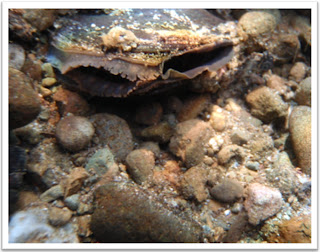Hello, Teal Waterstrat here to share more about our investigations into the freshwater mussels of western Washington.
 |
| Western Pearlshell mussels in Satsop River |
Freshwater mussels are relatives of the shellfish you find in Puget Sound and coastal waters. Unlike those shellfish, freshwater mussels need a fish to help them get around our rivers, streams, and lakes. Larval mussels, or glochidia, are released by the females and, with any luck, attach to a fish that takes them on a ride for several days to months. Once attached to the fish, the mussels grow into juveniles and drop off to the bed of the pond or stream and start growing into adults.
Last summer’s mussel surveys in the Satsop River drainage led to the observation of two additional Western Pearlshell (
Margaritifera falcata) mussel beds in the Satsop River watershed--one located in the headwaters of the East Fork Satsop River and another near the confluence of the Satsop and Chehalis River. One of the most immediate and striking things you notice when visiting these populations is the differences between in the size of mussels and how dissimilar their habitats are.
 |
| Upper Satsop River |
Up at the top of the Satsop River you can easily visit crystal clear waters in a pair of chestwaders any day of the year and find thousands of mussels. Down at the mouth of the Satsop and Chehalis Rivers, the beds are currently deep under high murky waters due to our springtime rains and runoff. High in the river we found thousands of "small" mussels, and even a number of baby mussels, in a complex habitat of braiding channels with lots of large wood and wetland plants. In the lower reaches, we observed relatively large mussels in what appear to be simple streambed habitats.
 |
| Western Pearlshell mussel |
Our investigations this coming summer will focus on understanding what creates the differences between populations--Is it the amount of food and calcium in the water making them grow bigger downstream, colder temperatures slowing growth in the headwaters, or perhaps more water moves bigger rocks necessitating bigger, tougher mussels? Which fish are they using as hosts and when do they spawn? Few studies have looked at these questions on the west side of Washington. Assessing and confirming the differences in mussel habitats and populations can tell us a lot about the variety of places they call home. It will also help us create informed management strategies in our freshwater ecosystems.
We will keep you posted as the field season progresses. Right now, we are setting up our monitoring sites and beginning to look for signs of female mussels getting ready to release their larvae.
You can help us study freshwater mussels, too. If you see any mussels, leave them in the water where you found them and send me an email (
Teal_Waterstrat@fws.gov) with the location, a description of the mussels, and a picture if possible.
--Teal Waterstrat, STEP Student






